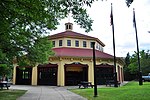D. H. & A. B. Tower

Doing business as D. H. & A. B. Tower, brothers David Horatio Tower (March 7, 1832 – December 22, 1907) and Ashley Bemis Tower (June 26, 1847 – July 8, 1901) were internationally known American architects, civil and mechanical engineers based in Holyoke, Massachusetts, who designed mills and factories in the United States from Maine to California as well as abroad, including in Canada, Mexico, Germany, Brazil, the United Kingdom, India, China, Japan, and Australia. By the time of its dissolution, the firm was described by one contemporary account as "the largest firm of paper mill architects in the country at that time"; its files reportedly contained more than 8,000 architectural plans for sites, mill machinery, and waterpower improvements.In a treatise on his own work in mill engineering, Joseph Wallace, former partner to Ashley B. Tower, lauded their work posthumously saying "the history of paper mill engineering is largely the story of the work of the 'Towers of Holyoke,' followed by the younger generation of engineers trained in the Tower offices." Their most famous works include Kimberly Clark's earliest pulp plants in Kimberly, Wisconsin for which Ashley B. Tower furnished designs, and David H. Tower's designs for Crane Currency, of Dalton, Massachusetts, for the first facilities to produce currency paper for the United States Bureau of Engraving and Printing.
Excerpt from the Wikipedia article D. H. & A. B. Tower (License: CC BY-SA 3.0, Authors, Images).D. H. & A. B. Tower
Race Street, Holyoke
Geographical coordinates (GPS) Address Nearby Places Show on map
Geographical coordinates (GPS)
| Latitude | Longitude |
|---|---|
| N 42.206192 ° | E -72.601977 ° |
Address
Race Street
Race Street
01040 Holyoke
Massachusetts, United States
Open on Google Maps











